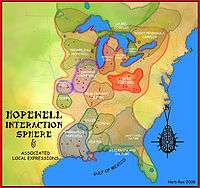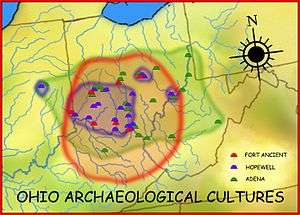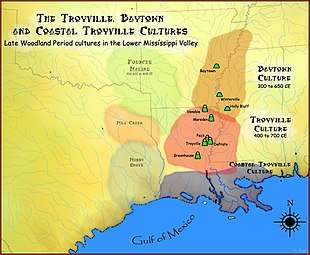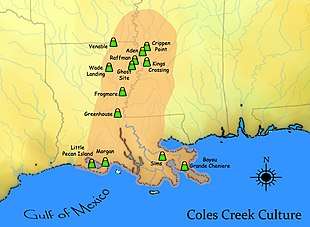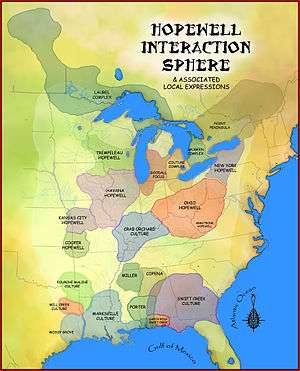Mound Builders
The various cultures collectively termed "Mound Builders" were inhabitants of North America who, during a 5,000-year period, constructed various styles of earthen mounds for religious, ceremonial, burial, and elite residential purposes. These included the pre-Columbian cultures of the Archaic period, Woodland period (Calusa culture, Adena and Hopewell cultures), and Mississippian period; dating from roughly 3500 BCE (the construction of Watson Brake) to the 16th century CE, and living in regions of the Great Lakes, the Ohio River Valley, and the Mississippi River valley and its tributary waters.[1]
Since the 19th century, the prevailing scholarly consensus has been that the mounds were constructed by indigenous peoples of the Americas. Sixteenth-century Spanish explorers met natives living in a number of later Mississippian cities, described their cultures, and left artifacts.[2] Research and study of these cultures and peoples has been based mostly on archaeology and anthropology.
Woodland culture
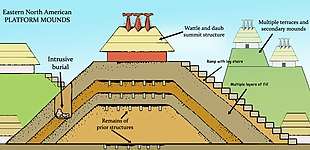
The namesake cultural trait of the Mound Builders was the building of mounds and other earthworks. These burial and ceremonial structures were typically flat-topped pyramids or platform mounds, flat-topped or rounded cones, elongated ridges, and sometimes a variety of other forms. They were generally built as part of complex villages. The early earthworks built in Louisiana around 3500 BCE are the only ones known to have been built by a hunter-gatherer culture.
The best-known flat-topped pyramidal structure, which at more than 100 feet (30 m) tall is the largest pre-Columbian earthwork north of Mexico, is Monks Mound at Cahokia near present-day Collinsville, Illinois. At its maximum about 1150 CE, Cahokia was an urban settlement with 20,000–30,000 people; this population was not exceeded by North American European settlements until after 1800.
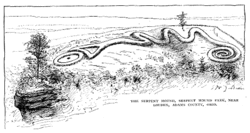
Some effigy mounds were constructed in the shapes or outlines of culturally significant animals. The most famous effigy mound, Serpent Mound in southern Ohio, ranges from 1 foot (0.30 m) to just over 3 feet (0.91 m) tall, 20 feet (6.1 m) wide, more than 1,330 feet (410 m) long, and shaped as an undulating serpent.
Many different tribal groups and chiefdoms, involving an array of beliefs and unique cultures over thousands of years, built mounds as expressions of their cultures. The general term, "mound builder", covered their shared architectural practice of earthwork mound construction. This practice, believed to be associated with a cosmology that had a cross-cultural appeal, may indicate common cultural antecedents. The first mound building was an early marker of political and social complexity among the cultures in the Eastern United States. Watson Brake in Louisiana, constructed about 3500 BCE during the Middle Archaic period, is the oldest dated mound complex in North America. It is one of 11 mound complexes from this period found in the Lower Mississippi Valley.[3]
These mound builders were organized; hundreds or even thousands of workers had to dig up tons of earth with the hand tools available, the soil had to be moved long distances, and finally, workers had to create the shape the builder had planned.
Archaeological surveys
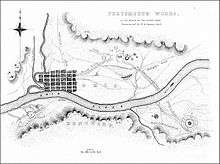
The most complete reference for these earthworks is Ancient Monuments of the Mississippi Valley, written by Ephraim G. Squier and Edwin H. Davis. It was published in 1848 by the Smithsonian Institution. Since many of the features which the authors documented have since been destroyed or diminished by farming and development, their surveys, sketches, and descriptions are still used by modern archaeologists. All of the sites which they identified as located in Kentucky came from the manuscripts of C. S. Rafinesque.
Reports of early European explorers
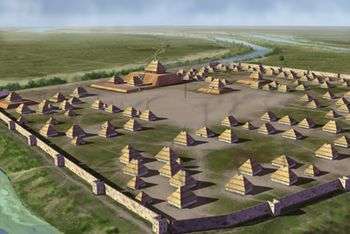
Hernando de Soto, the Spanish conquistador, between 1540–1542 traversed what became the southeastern United States. There he encountered many different mound-builder peoples who were perhaps descendants of the great Mississippian culture. The mound-building tradition still existed in the southeast during the mid-16th century. De Soto observed people living in fortified towns with lofty mounds and plazas, and surmised that many of the mounds served as foundations for priestly temples. Near present-day Augusta, Georgia, de Soto encountered a mound-building group ruled by a queen, Cofitachequi. She told him that the mounds within her territory served as the burial places for nobles.
_(20396721516).jpg)
The artist Jacques le Moyne, who had accompanied French settlers to northeastern Florida during the 1560s, likewise noted many Native American groups using existing mounds and constructing others. He produced a series of watercolor paintings depicting scenes of native life. Although most of his paintings have been lost, some engravings were copied from the originals and published in 1591 by a Flemish company. Among these is a depiction of the burial of an aboriginal Floridian tribal chief, an occasion of great mourning and ceremony. The original caption reads:
Sometimes the deceased king of this province is buried with great solemnity, and his great cup from which he was accustomed to drink is placed on a tumulus with many arrows set about it.
— Jacques le Moyne, 1560s
Maturin Le Petit, a Jesuit priest, met the Natchez people as did Le Page du Pratz (1758), a French explorer. Both observed them in the area that later became Mississippi. The Natchez were devout worshippers of the sun. Having a population of some 4,000, they occupied at least nine villages and were presided over by a paramount chief, known as the Great Sun, who wielded absolute power. Both observers noted the high temple mounds which the Natchez had built so that the Great Sun could commune with God, the sun. His large residence was built atop the highest mound, from "which, every morning, he greeted the rising sun, invoking thanks and blowing tobacco smoke to the four cardinal directions".[4][5][6]
Later explorers to the same regions, only a few decades after mound-building settlements had been reported, found the regions largely depopulated, the residents vanished, and the mounds untended. Since little violent conflict with Europeans had occurred in that area during that period, the most plausible explanation is that infectious diseases from the Old World, such as smallpox and influenza, had decimated most of the Native Americans who had comprised the last mound-builder civilization.[7][8][9][10]
Mound-building cultures
Archaic era
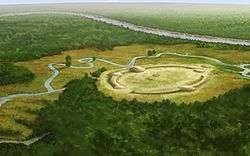
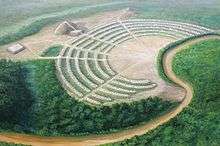
Radiocarbon dating has established the age of the earliest Archaic mound complex in southeastern Louisiana. One of the two Monte Sano Site mounds, excavated in 1967 before being destroyed for new construction at Baton Rouge, was dated at 6220 BP (plus or minus 140 years).[11] Researchers at the time thought that such societies were not organizationally capable of this type of construction.[11] It has since been dated as about 6500 BP, or 4500 BCE,[12] although not all agree.[13]
Watson Brake is located in the floodplain of the Ouachita River near Monroe in northern Louisiana. Securely dated to about 5,400 years ago (around 3500 BCE), in the Middle Archaic period, it consists of a formation of 11 mounds from 3 feet (0.91 m) to 25 feet (7.6 m) tall, connected by ridges to form an oval nearly 900 feet (270 m) across.[14] In the Americas, building of complex earthwork mounds started at an early date, well before the pyramids of Egypt were constructed. Watson Brake was being constructed nearly 2,000 years before the better-known Poverty Point, and building continued for 500 years.[14] Middle Archaic mound construction seems to have ceased about 2800 BCE, and scholars have not ascertained the reason, but it may have been because of changes in river patterns or other environmental factors.[15]
With the 1990s dating of Watson Brake and similar complexes, scholars established that pre-agricultural, pre-ceramic American societies could organize to accomplish complex construction during extended periods of time, invalidating scholars' traditional ideas of Archaic society.[16] Watson Brake was built by a hunter-gatherer society, the people of which occupied the area on only a seasonal basis, but where successive generations organized to build the complex mounds over a 500-year period. Their food consisted mostly of fish and deer, as well as available plants.
Poverty Point, built about 1500 BCE in what is now Louisiana, is a prominent example of Late Archaic mound-builder construction (around 2500 BCE – 1000 BCE). It is a striking complex of more than 1 square mile (2.6 km2), where six earthwork crescent ridges were built in concentric arrangement, interrupted by radial aisles. Three mounds are also part of the main complex, and evidence of residences extends for about 3 miles (4.8 km) along the bank of Bayou Macon. It is the major site among 100 associated with the Poverty Point culture and is one of the best-known early examples of earthwork monumental architecture. Unlike the localized societies during the Middle Archaic, this culture showed evidence of a wide trading network outside its area, which is one of its distinguishing characteristics.
Horr's Island, Florida, now a gated community next to Marco Island, when excavated by Michael Russo in 1980 found an Archaic Indian village site. Mound A was a burial mound that dated to 3400 BCE, making it the oldest known burial mound in North America.[17]
Woodland period
The oldest mound associated with the Woodland period was the mortuary mound and pond complex at the Fort Center site in Glade County, Florida. 2012 excavations and dating by Thompson and Pluckhahn show that work began around 2600 BCE, seven centuries before the mound-builders in Ohio.
The Archaic period was followed by the Woodland period (circa 1000 BCE). Some well-understood examples are the Adena culture of Ohio, West Virginia, and parts of nearby states. The subsequent Hopewell culture built monuments from present-day Illinois to Ohio; it is renowned for its geometric earthworks. The Adena and Hopewell were not the only mound-building peoples during this time period. Contemporaneous mound-building cultures existed throughout what is now the Eastern United States, stretching as far south as Crystal River in western Florida. During this time, in parts of present-day Mississippi, Arkansas, and Louisiana, the Hopewellian Marksville culture degenerated and was succeeded by the Baytown culture.[18] Reasons for degeneration include attacks from other tribes or the impact of severe climatic changes undermining agriculture.
Coles Creek culture
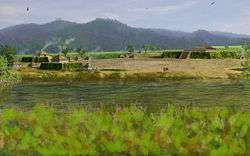
The Coles Creek culture is a Late Woodland culture (700-1200 CE) in the Lower Mississippi Valley in the Southern United States that marks a significant change of the cultural history of the area. Population and cultural and political complexity increased, especially by the end of the Coles Creek period. Although many of the classic traits of chiefdom societies were not yet made, by 1000 CE, the formation of simple elite polities had begun. Coles Creek sites are found in Arkansas, Louisiana, Oklahoma, Mississippi, and Texas. The Coles Creek culture is considered ancestral to the Plaquemine culture.[19][20]
Mississippian cultures
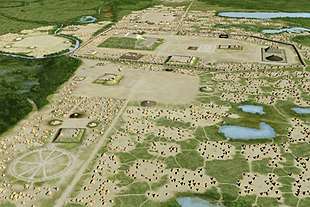
Around 900–1450 CE, the Mississippian culture developed and spread through the Eastern United States, primarily along the river valleys.[21] The largest regional center where the Mississippian culture is first definitely developed is located in Illinois near the Mississippi, and is referred to presently as Cahokia. It had several regional variants including the Middle Mississippian culture of Cahokia, the South Appalachian Mississippian variant at Moundville and Etowah, the Plaquemine Mississippian variant in south Louisiana and Mississippi,[22] and the Caddoan Mississippian culture of northwestern Louisiana, eastern Texas, and southwestern Arkansas.[23] Like the mound builders of the Ohio, these people built gigantic mounds as burial and ceremonial places.[24]
Fort Ancient culture
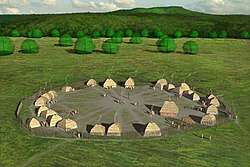
Fort Ancient is the name for a Native American culture that flourished from 1000 to 1650 CE among a people who predominantly inhabited land along the Ohio River in areas of modern-day southern Ohio, northern Kentucky, and western West Virginia.
Plaquemine culture
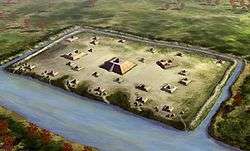
A continuation of the Coles Creek culture in the lower Mississippi River Valley in western Mississippi and eastern Louisiana. Examples include the Medora Site in West Baton Rouge Parish, Louisiana; and the Anna and Emerald Mound sites in Mississippi. Sites inhabited by Plaquemine peoples continued to be used as vacant ceremonial centers without large village areas much as their Coles Creek ancestors had done, although their layout began to show influences from Middle Mississippian peoples to the north. The Winterville and Holly Bluff (Lake George) sites in western Mississippi are good examples that exemplify this change of layout, but continuation of site usage.[25] During the Terminal Coles Creek period (1150 to 1250 CE), contact increased with Mississippian cultures centered upriver near St. Louis, Missouri. This resulted in the adaption of new pottery techniques, as well as new ceremonial objects and possibly new social patterns during the Plaquemine period.[26] As more Mississippian culture influences were absorbed, the Plaquemine area as a distinct culture began to shrink after CE 1350. Eventually, the last enclave of purely Plaquemine culture was the Natchez Bluffs area, while the Yazoo Basin and adjacent areas of Louisiana became a hybrid Plaquemine-Mississippian culture.[27] This division was recorded by Europeans when they first arrived in the area. In the Natchez Bluffs area, the Taensa and Natchez people had held out against Mississippian influence and continued to use the same sites as their ancestors, and the Plaquemine culture is considered directly ancestral to these historic period groups encountered by Europeans.[28] Groups who appear to have absorbed more Mississippian influence were identified as those tribes speaking the Tunican, Chitimachan, and Muskogean languages.[26]
Archaeological culture maps


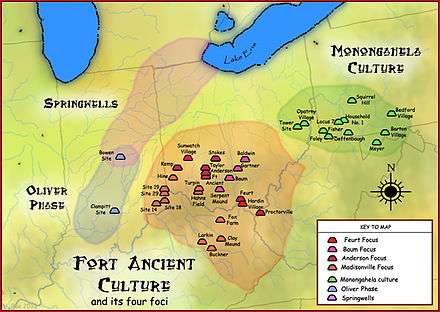 Fort Ancient culture
Fort Ancient culture
Alternative explanations
Through the mid-19th century, European Americans did not recognize that ancestors of the Native Americans had built the prehistoric mounds of the eastern U.S. They believed that the massive earthworks and large ceremonial complexes were built by a different people. A New York Times article from 1897 described a mound in Wisconsin in which a giant human skeleton measuring over 9 feet (2.7 m) in length was found.[29] From 1886, another New York Times article described water receding from a mound in Cartersville, Georgia, which uncovered acres of skulls and bones, some of which were said to be gigantic. Two thigh bones were measured with the height of their owners estimated at 14 feet (4.3 m).[30] President Lincoln made reference to the giants whose bones fill the mounds of America.
"But still there is more. It calls up the indefinite past. When Columbus first sought this continent – when Christ suffered on the cross – when Moses led Israel through the Red-Sea – nay, even, when Adam first came from the hand of his Maker – then as now, Niagara was roaring here. The eyes of that species of extinct giants, whose bones fill the mounds of America, have gazed on Niagara, as ours do now. Co[n]temporary with the whole race of men, and older than the first man, Niagara is strong, and fresh to-day as ten thousand years ago. The Mammoth and Mastodon – now so long dead, that fragments of their monstrous bones, alone testify, that they ever lived, have gazed on Niagara. In that long – long time, never still for a single moment. Never dried, never froze, never slept, never rested."[31]
The antiquarian author William Pidgeon created fraudulent surveys of mound groups that did not exist, possibly tainting this opinion, which was replaced by others.[32][33][34]
A major factor in increasing public knowledge of the origins of the mounds was the 1894 report by Cyrus Thomas of the Bureau of American Ethnology. He concluded that the prehistoric earthworks of the Eastern United States were the work of early cultures of Native Americans. A small number of people had earlier made similar conclusions: Thomas Jefferson, for example, excavated a mound and from the artifacts and burial practices, noted similarities between mound-builder funeral practices and those of Native Americans in his time. In addition, Theodore Lewis in 1886 had refuted Pidgeon's fraudulent claims of pre-Native American moundbuilders.[35]
Writers and scholars have proposed many alternative origins for the Mound Builders:
- Vikings
In 1787, Benjamin Smith Barton proposed the theory that the Mound Builders were Vikings who came to North America and eventually disappeared.[36]
- Ancient world immigrants
Other people believed that Greeks, Africans, Chinese, or assorted Europeans built the mounds. Some Euro-Americans thought the Ten Lost Tribes of Israel had built the mounds.[36]
- Book of Mormon inhabitants
During the 19th century, a common belief was that the Jews, particularly the Lost Ten Tribes, were the ancestors of Native Americans and the Mound Builders.[37] The Book of Mormon (published first in 1830) provides a related belief, as its narrative describes two major immigrations to the Americas from Mesopotamia: the Jaredites (3000–2000 BCE) and an Israelite group in 590 BCE (termed Nephites, Lamanites, and Mulekites). While the Nephites, Lamanites, and Mulekites were all of Jewish origin coming from Israel around 590 BCE, the Jaradites were a non-Abrahamic people separate in all aspects, except in a belief in Jehovah, from the Nephites. The Book of Mormon depicts these settlers building magnificent cities, which were destroyed by warfare about CE 385.
Numerous observers have suggested that the Book of Mormon appears to be a work of fiction that parallels others within the 19th-century "mound-builder" genre that was pervasive at the time.[38][39][40][41][42][43] Some nineteenth-century archaeological finds (e.g., earth and timber fortifications and towns,[44] the use of a plaster-like cement,[45] ancient roads,[46] metal points and implements,[47] copper breastplates,[48] head-plates,[49] textiles,[50] pearls,[51] native North American inscriptions, North American elephant remains etc.) were well-publicized at the time of the publication of the Book of Mormon and there is incorporation of some of these ideas into the narrative. References are made in the Book of Mormon to then-current understanding of pre-Columbian civilizations, including the Formative Mesoamerican civilizations such as the (Pre-Classic) Olmec, Maya, and Zapotec.
- Black civilizations
During the 20th century, certain sects affiliated with the Black nationalist Moorish Science philosophy theorized an association with the Mound Builders.[52][53] They argue that the Mound Builders were an ancient advanced Black civilization that developed the legendary continents of Atlantis and Mu, as well as ancient Egypt and Mesoamerica. These Black groups claim that the American Indians were too primitive to have developed the sophisticated societies and the technology believed necessary to build the mounds.
- Divine creation
The Reverend Landon West claimed that Serpent Mound in Ohio was built by God, or by man inspired by him. He believed that God built the mound and placed it as a symbol of the story of the Garden of Eden.[54][55]
- Mythical cultures
Some people attributed the mounds to mythical cultures: Lafcadio Hearn suggested that the mounds were built by people from the lost continent of Atlantis.[36][56]
Effects of alternative explanations
The mound-builder explanations were often honest misinterpretations of real data from valid sources. Both scholars and laymen accepted some of these explanations. Reference to an alleged race appears in the poem "The Prairies" (1832) by William Cullen Bryant.[57]
- Assumption that construction was too complex for Native Americans
One belief was that Native American Indians were too unsophisticated to have constructed such complex earthworks and artifacts. The associated stone, metal, and clay artifacts were thought to be too complex for ancient Native Americans to have made. In the American Southeast and Midwest, numerous Native American cultures were sedentary and used agriculture. Numerous Native American towns had built surrounding stockades for defense. Capable of this type of construction, their ancestors and they could have built mounds, but people who believed that Native Americans did not build the earthworks did not analyze it in this manner. They thought the Native American nomadic cultures would not organize to build such monuments, for failure to devote the time and effort to construct such time-consuming projects.[36]
When British colonists first arrived in America, they did not witness the Native Americans building mounds and these colonists reported that few Native Americans (specifically referring to those Native Americans living in this area newly colonized by England) on the Atlantic coast - knew of their own (ancient ?) history when asked. Yet earlier Europeans, especially the Spanish, had written numerous non-English-language accounts about the Indians' construction of mounds. Garcilaso de la Vega reported how the Indians built the mounds and placed temples on top of them. A few French expeditions reported staying with Indian societies who had built mounds also.[36]
- Assumption that construction was older than Native Americans known to European Americans at that time.
People also claimed that Native Americans were not the Mound Builders because the mounds and related artifacts were older than Native American cultures known by European Americans at that time. For example, Caleb Atwater's misunderstanding of stratigraphy caused him to believe that the Mound Builders were a much older civilization than known Native Americans. In his book, Antiquities Discovered in the Western States (1820), Atwater claimed that Indian remains were always found right beneath the surface of the earth. Since the artifacts associated with the Mound Builders were found fairly deep in the ground, Atwater argued that they must be from a different group of people. The discovery of metal artifacts further convinced people that the Mound Builders were not Native Americans. This is because the Native Americans encountered by the Europeans and European Americans were not thought to engage in metallurgy. Some artifacts that were found in relation to the mounds were inscribed with symbols. As the Europeans did not know of any Native American cultures that had a writing system, they assumed a different group had created them.[36]
Hoaxes

Several hoaxes have involved the Mound Builder cultures.
- Newark Holy Stones
- In 1860, David Wyrick discovered the "Keystone tablet", containing Hebrew language inscriptions written on it, in Newark, Ohio. Soon afterward, he found the "Newark Decalogue Stone" nearby, also claimed to be inscribed in Hebrew. The authenticity of the "Newark Holy Stones" and the circumstances of their discovery are disputed.[36]
- Davenport tablets
- Reverend Jacob Gass discovered what were called the "Davenport tablets" in Iowa in the 1870s. These bore inscriptions that later were determined to be fake.[36]
- Walam Olum hoax
- The Walam Olum hoax had considerable influence on perceptions of the Mound Builders. In 1836, Constantine Samuel Rafinesque published his translation of a text he claimed had been written in pictographs on wooden tablets. This text explained that the Lenape Indians originated in Asia, told of their passage over the Bering Strait, and narrated their subsequent migration across the North American continent. This "Walam Olum" tells of battles with native peoples already in America before the Lenape arrived. People hearing of the account believed that the "original people" were the Mound Builders, and that the Lenape overthrew them and destroyed their culture. David Oestreicher later asserted that Rafinesque's account was a hoax. He argued that the Walam Olum glyphs derived from Chinese, Egyptian, and Mayan alphabets. Meanwhile, the belief that the Native Americans destroyed the mound-builder culture had gained widespread acceptance.[36]
- Kinderhook plates
- Another hoax, the "Kinderhook plates" "discovered" in 1843, involved material planted by a contemporary in Native American mounds. This hoax aimed to discredit the account of the Mormon prophet Joseph Smith having translated an ancient book.[58][59]
See also
- List of burial mounds in the United States
- Petroform
- Prehistory of Ohio
- Southeastern Ceremonial Complex
- Southwestern Moundbuilders, athletic teams of Southwestern College in Winfield, Kansas
- Tumulus, mounds (or barrows) of Europe and Asia
- Tumulus culture
References
- Squier p. 1
- Constance E. Richards, "Contact and Conflict", American Archaeologist, Spring 2004, accessed 26 Jun 2008
- Robert W. Preucel, Stephen A. Mrozowski, Contemporary Archaeology in Theory: The New Pragmatism, John Wiley & Sons, 2010, p. 177
- Mallory O'Connor, Lost Cities of the Ancient Southeast (University Press of Florida, 1995).
- Ephraim Squier and Edwin Davis, Ancient Monuments of the Mississippi Valley (Smithsonian Contributions to Knowledge, vol. 1. Washington DC, 1848)
- Biloine Young and Melvin Fowler, Cahokia: The Great Native American Metropolis (University of Illinois Press, 2000).
- Davis Brose and N'omi Greber (eds.), Hopewell Archaeology (Kent State University Press, 1979)
- Roger Kennedy, Hidden Cities: The Discovery and Loss of Ancient North American Civilization (Free Press, 1994)
- Robert Silverberg, "...And the Mound-Builders Vanished from the Earth", originally in the 1969 edition of American Heritage, collected in the anthology A Sense of History [Houghton-Mifflin, 1985]; available online here Archived 2008-08-28 at the Wayback Machine.
- Gordon M. Sayre, "The Mound Builders and the Imagination of American Antiquity in Jefferson, Bartram, and Chateaubriand", Early American Literature 33 (1998): 225–249.
- Rebecca Saunders, "The Case for Archaic Period Mounds in Southeastern Louisiana", Southeastern Archaeology, Vol. 13, No. 2, Winter 1994, accessed 4 November 2011
- "Important new findings in Louisiana". Archaeo News. Stone Pages. Retrieved 5 September 2011.
- Joe W. Saunders, "Middle Archaic and Watson Brake", in Archaeology of Louisiana, edited by Mark A. Rees, Ian W. (FRW) Brown, LSU Press, 2010, p. 67
- Saunders, in Rees and Brown (2010), Archaeology of Louisiana, pp. 69–76
- Saunders, in Rees and Brown (2010), Archaeology of Louisiana, pp. 73–74
- Saunders, in Rees and Brown (2010), Archaeology of Louisiana, p. 63
- Russo, Brown
- "Southeastern Prehistory-Late Woodland Period". Retrieved 2008-09-23.
- Kidder, Tristram (1998). R. Barry Lewis; Charles Stout (eds.). Mississippian Towns and Sacred Spaces. University of Alabama Press. ISBN 978-0-8173-0947-3.
- "Troyville-Coles Creek". Louisiana prehistory. 2010-07-01. Archived from the original on 2012-01-10.
- Adam King (2002). "Mississippian Period: Overview". New Georgia Encyclopedia. Retrieved 2010-07-01.
- "Mississippian and Late Prehistoric Period". Retrieved 2010-07-01.
- Peter N. Peregrine (1995). Archaeology of the Mississippian culture: a research guide. Garland Publishing. p. 165. ISBN 978-0-8153-0336-7.
- Nash, Gary B. Red, White and Black: The Peoples of Early North America Los Angeles 2015. Chapter 1, p. 6
- "Mississippian and Late Prehistoric Period". Retrieved 2016-10-20.
- "Plaquemine-Mississippian". Retrieved 2016-10-20.
- Guy E. Gibbon; Kenneth M. Ames (1998-08-01). Archaeology of prehistoric native America: an encyclopedia. Routledge. pp. 657–658. ISBN 978-0-8153-0725-9.
- "The Plaquemine Culture, A.D 1000". Retrieved 2008-09-08.
- "Wisconsin Mound Opened: Skeleton Found of a Man Over Nine Feet High with an Enormous Skull". New York Times. December 20, 1897.
- "Monster Skulls and Bones". New York Times. April 5, 1886.
- Lincoln, Abraham (1953). "Fragment: Niagara Falls [c. September 25–30, 1848]". In Basler, Roy P. (ed.). Collected Works of Abraham Lincoln. 2. pp. 10–11.
- Pidgeon, William (1858) Traditions of Dee-Coo-Dah and Antiquarian Researches. Horace Thayer, New York.
- Finney, Fred (2008) William Pidgeon and T.H. Lewis. Minnesota Archaeologist 67: 89–105
- Birmingham, Robert A. and Leslie E. Eisenberg (2000) Indian Mounds of Wisconsin. University of Wisconsin Press, Madison, Wisconsin, pp. 24–27.
- Lewis, Theodore H. (1886) "The 'Monumental Tortoise' Mounds of 'Dee-Coo-Dah'" The American Journal of Archaeology 2(1):65–69.
- Feder, Kenneth L. (2005). "The Myth of the Moundbuilders" (PDF). Frauds, Myths, And Mysteries: Science and Pseudoscience in Archaeology. Central Connecticut State Univ: McGraw Hill. pp. 151–155, 159–160, 164–166. ISBN 978-0-07-286948-4. Retrieved May 19, 2012.
- Chapman, Jefferson. "Prehistoric American Indians in Tennessee". University of Tennessee, Knoxville. Archived from the original on 2012-02-05. Retrieved 2012-02-08.
- Silverberg 1969.
- Kennedy 1994.
- Garlinghouse, Thomas, "Revisiting the Mound Builder Controversy", History Today, September 2001, Vol. 51, Issue 9, p. 38.
- Robert Silverberg, Mound Builders of Ancient America: The Archeology of a Myth (New York: New York Graphic Society, 1968); Silverberg 1969.
- Curtis Dahl, "Mound-Builders, Mormons, and William Cullen Bryant", The New England Quarterly, vol. 34, no. 2, June 1961, pp. 178–90 ("Undoubtedly the most famous and certainly the most influential of all Mound-Builder literature is the Book of Mormon (1830)). Whether one wishes to accept it as divinely inspired or the work of Joseph Smith, it fits exactly into the tradition. Despite its pseudo-Biblical style and its general inchoateness, it is certainly the most imaginative and best sustained of the stories about the Mound-Builders" (at p. 187).
- Fawn M. Brodie, No Man Knows My History: The Life of Joseph Smith (rev. ed., New York: Knopf, 1971) p. 36.
- See Squier 1849
- See mound builder homes of "clay-plastered poles": Stuart, George E., Who Were the "Mound Builders"?, National Geographic, Vol. 142, No. 6, December 1972, pg. 789
- See Searching for the Great Hopewell Road, based on the investigations of archaeologist Dr. Bradley Lepper, Ohio Historical Society, Pangea Production Ltd, 1998
- See Priest, Josiah, American Antiquities and Discoveries in the West, pg. 179;
- See Mound Builders & Cliff Dwellers, Lost Civilizations series, Dale M. Brown (editor), pg. 26
- Priest, Josiah, American Antiquities and Discoveries in the West, 176; Mound Builders & Cliff Dwellers, Lost Civilizations series, Dale M. Brown (editor), pg. 26
- See Ritchie, William A. The Archaeology of New York State, pp. 259, 261
- See freshwater pearl necklaces, and pearls sewn on clothing: Mound Builders & Cliff Dwellers, Lost Civilizations series, Dale M. Brown (editor), pg. 26
- "The Mound Builders of North America Part I". Federation : MSTA. Retrieved 2017-12-24.
- "The Black Washitaw Nation of America". Retrieved 2017-12-24.
- Ohio Historical Society (1901). Ohio history, Volume 10. Retrieved 2011-07-25.
The Garden of Eden, it seems, is now definitely located. The site is in Ohio, "Adams" county, to be more precise...The Rev. Landon West of Pleasant Hill, O., a prominent and widely known minister of the Baptist church... arrives at the conclusion that this great work was created either by God himself or by man inspired by Him to make an everlasting object lesson of man's disobedience, Satan's perfidy and the results of sin and death. In support of this startling claim the Rev. Mr. West quotes Scripture and refers to Job 16:13: "By His spirit. He hath garnished the heavens; His hand hath formed the crooked serpent."
- Brook Wilensky-Lanford (May 23, 2011). "Adam and Eve –and Reverend West – in Ohio". The Common. Archived from the original on 2011-11-04. Retrieved 2011-07-25.
The Eden I found in a 1909 pamphlet by Reverend Landon West—the Serpent Mound earthwork that is now an Ohio state park—was still preserved for all to see, so I went...Details that fell outside of West's lifetime were hard to fit into the book: his son Dan West became the founder of the Heifer Project charity, and his accomplishments no doubt helped preserve the memory of his father's Garden of Eden.
- Hearn, Lafcadio (April 24, 1876). "The Mound Builders". The Commercial. Retrieved May 17, 2012.
- Bryant, William Cullen, "The Prairies" (1832) Archived 2007-01-05 at the Wayback Machine
- Kimball, Stanley B. (Aug. 1981). "Kinderhook Plates Brought to Joseph Smith Appear to Be a Nineteenth-Century Hoax". Ensign (LDS Church). Retrieved May 17, 2012.
- Evans, Glenn; Groat, Joel B. (2003). "Joseph Smith and the Kinderhook Plates: Overview and Current Perspectives". Mormons in Transition (IRR). Retrieved May 17, 2012.
Further reading
- Abrams, Elliot M.; Freter, AnnCorinne, eds. (2005). The Emergence of the Moundbuilders: The Archaeology of Tribal Societies in Southeastern Ohio. Athens: Ohio University Press. ISBN 978-0-8214-1609-9.
- Thomas, Cyrus. Report on the mound explorations of the Bureau of Ethnology. pp. 3–730. Twelfth annual report of the Bureau of Ethnology to the Secretary of the Smithsonian Institution, 1890–91, by J. W. Powell, Director. XLVIII+742 pp., 42 pls., 344 figs. 1894.
- Feder, Kenneth L. Frauds, Myths, and Mysteries: Science and Pseudoscience in Archaeology. 5th ed. New York: McGraw Hill, 2006.
- Squier, E. G.; Davis, E. H. (1847). Ancient Monuments of the Mississippi Valley. Washington DC: Smithsonian Institution.
- Gale, George (1867). Upper Mississippi: or, Historical Sketches of the Mound-builders, the Indian tribes and the Progress of Civilization in the North-west, from A.D. 1600 to the Present Time. Chicago: Clarke.
External links
| Wikisource has the text of the 1911 Encyclopædia Britannica article Mound-builders. |
- Lost Race Myth
- LenaweeHistory.com | Mound Builders section, The Western Historical Society 1909, reprint.
- Artist Hideout, Art of the Ancients
- Ancient Monuments Placemarks
- The Mound Builders at Project Gutenberg
- With Climate Swing, a Culture Bloomed in Americas (mound builders in Peru)
- Science 19 September 1997 (a mound complex in Louisiana at 5400u–5000 years ago)
- Bruce Smith video on the 1880s Smithsonian explorations to determine who built the ancient earthen mounds in eastern North America can be viewed as part of the series 19th Century Explorers and Anthropologists: Developing the Earliest Smithsonian Anthropology Collections

